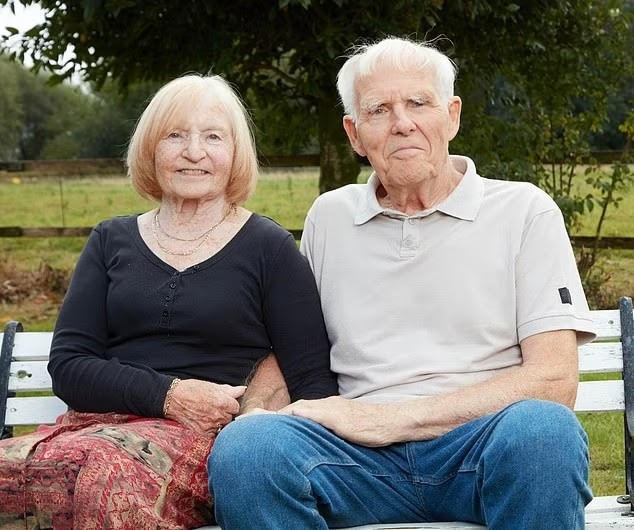In a heartfelt decision that intertwines love, aging, and the right to choose, Peter and Christine Scott, a British couple married for nearly 50 years, are preparing to embark on a journey like no other. This September, they plan to end their lives together in a Sarco suicide pod in Switzerland, a decision catalyzed by Christine’s recent diagnosis of early-stage vascular dementia. Their choice not only reflects the depth of their bond but also opens a discussion about the ethics of assisted dying and personal autonomy in end-of-life decisions.
A Decision Rooted in Love and Fear
Peter Scott, 86, a retired RAF engineer, has expressed his profound sentiments about their relationship and the idea of facing life without Christine. “I cannot bear the thought of living without my wife,” he said, encapsulating the essence of their long-lasting partnership. After 46 years of shared experiences, they have forged a connection that transcends traditional marital bonds, emphasizing mutual support and unwavering commitment.
Christine, now 80, is not just a devoted wife; she is also a retired nurse who understands the implications of her diagnosis. Her experience caring for patients with dementia has shaped her perspective on her own health. “I want to remain in control of myself and my life,” she asserted, reflecting a desire for agency in a situation where many feel powerless. This proactive approach underscores their shared decision to seek an end on their own terms.
The couple’s choice has been made after extensive conversations with their children. While initially hesitant, their children have ultimately come to accept their parents’ wishes. This acceptance speaks volumes about the complexities involved in discussing end-of-life choices within families, highlighting the emotional weight of such decisions.
The Challenges of Aging
Aging brings its own set of challenges, and the Scotts have voiced their concerns about what the future may hold. They worry about the potential for prolonged suffering within the current healthcare system, particularly given their fears surrounding the inadequacies of the NHS. “I don’t want to go into care, lying in bed dribbling and incontinent. I don’t call that a life,” Peter remarked. This sentiment is echoed by many in similar situations, who seek to avoid a loss of dignity in their final years.
Their concerns also extend to financial burdens, particularly the costs associated with long-term care. Peter and Christine fear that years of expensive healthcare could deplete their life savings and threaten their home. These factors contribute to their desire for control over their circumstances, ultimately leading them to consider the Sarco pod as a viable option for assisted dying.
Understanding the Sarco Pod
The Sarco pod, frequently dubbed the “Tesla of euthanasia,” represents a modern approach to assisted dying that seeks to provide a peaceful, dignified option for those facing terminal conditions or unbearable suffering. Designed by Philip Nitschke, an Australian physician known for his advocacy for assisted suicide, the pod embodies a sleek, futuristic aesthetic that aims to alleviate some of the discomfort associated with dying.
Currently, the Scotts are awaiting the launch of a new twin Sarco model, which will allow them to die side by side. This aspect of their decision highlights their unwavering commitment to facing the end of life together, showcasing the love and companionship that has defined their relationship throughout the years.
In Switzerland, where voluntary assisted dying has been legal since 1942, the Sarco pod operates within a framework of strict legal criteria. Individuals seeking to end their lives must demonstrate that they are of sound mind and are not acting under coercion or duress. This regulatory structure is designed to ensure that the choice for assisted dying is made with thoughtful consideration and autonomy.

How the Sarco Pod Works
The Sarco pod offers a quick, painless exit from life, typically taking about ten minutes from activation to death. When the pod is activated, it fills its chamber with nitrogen while simultaneously reducing oxygen levels. This dual process leads to a state of unconsciousness, followed by death within minutes, providing a humane alternative for those seeking an end to their suffering.
Inside the pod, users are guided by a voice that prompts them to initiate the process. “If you want to die, press this button,” they hear, reinforcing the idea that the decision remains entirely in the user’s hands. The activation mechanism is designed with accessibility in mind, allowing users to control the process through various means, including gestures and voice commands.
This level of autonomy is particularly significant for individuals who may face physical limitations or communication challenges. The Sarco pod aims to empower users, enabling them to make choices about their own lives—even in the most challenging circumstances.
Planning Their Final Days
As Peter and Christine prepare for this momentous transition, they are taking steps to ensure that their final days are meaningful. Christine has envisioned how she would like to spend her last moments, expressing a desire for beauty and enjoyment despite the gravity of their decision. “I’d like to go walking with Peter in the Swiss Alps, by a river. I’d have a beautiful plate of fish for my last supper and enjoy a great bottle of Merlot,” she said, underscoring her wish to savor life until the very end.
Christine has also curated a playlist for her final moments, choosing songs that resonate deeply with her emotions. “I’ve found a poem called ‘Miss Me But Let Me Go,’ which sums up exactly how I feel,” she shared. This attention to detail highlights the importance of personal meaning in their final journey, reflecting a desire for joy even in the face of profound loss.
Reflections on Life and Death
The Scotts’ choice has sparked important conversations about the nature of life, love, and death. For many, the concept of assisted dying remains controversial and elicits a range of emotional responses. While some view it as a humane option for those suffering, others express concerns about its implications for society, particularly regarding the elderly and vulnerable populations.
Critics often raise alarms about the potential for abuse or coercion, fearing that individuals may feel pressured to end their lives. However, proponents argue that the ability to choose a dignified death is a fundamental human right. The Scotts’ story exemplifies the complexity of these discussions, illustrating that their decision stems from love and mutual support rather than desperation or hopelessness.
The Broader Context of Assisted Dying
The legality of assisted dying varies significantly across different regions. In Switzerland, where the Scotts are headed, individuals have the right to choose assisted dying under strict regulations. However, in the UK, euthanasia and assisted suicide remain illegal, with harsh penalties for those who assist in such actions. This legal disparity has ignited ongoing debates about the ethics of assisted dying, particularly as more individuals seek the right to make choices about their own end-of-life experiences.
The Scotts’ situation prompts reflection on how society views aging, suffering, and autonomy. Their decision highlights the urgent need for dialogue about assisted dying, personal choice, and the ethics surrounding these sensitive issues.
Conclusion
As Peter and Christine Scott prepare to take this extraordinary step, their journey serves as a poignant reminder of the complexities surrounding love, aging, and the right to choose one’s own path in life—and death. Their decision reflects not only a deep commitment to one another but also challenges societal norms and legal frameworks regarding assisted dying.
In sharing their story, the Scotts invite readers to contemplate the profound questions of personal autonomy and dignity, fostering a broader dialogue about the choices individuals face as they approach the end of life. As they navigate this final chapter together, their hope is to inspire understanding and respect for individual choices in the face of life’s inevitable challenges.

